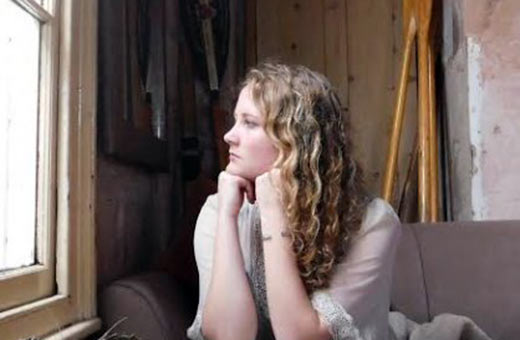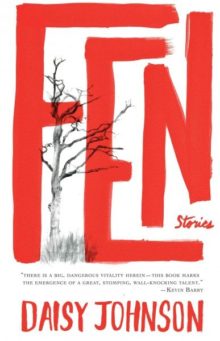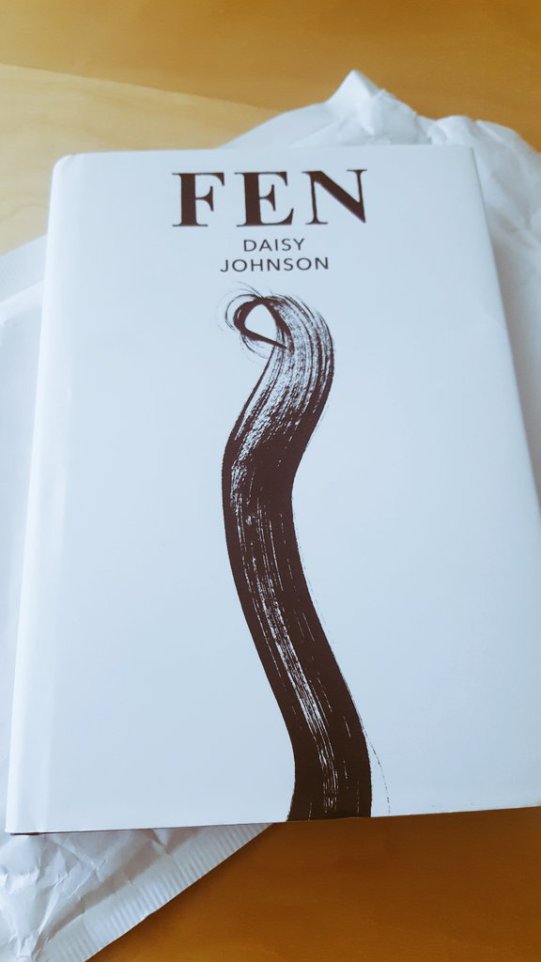Interview by Katy Wimhurst
 Congratulations on your collection of short stories, FEN, being shortlisted for the Edge Hill Prize. What is it about the short story form that appeals to you?
Congratulations on your collection of short stories, FEN, being shortlisted for the Edge Hill Prize. What is it about the short story form that appeals to you?
Thank you! So many things. Their brevity, their strangeness, their beauty. I was studying short stories when I started writing FEN and they creep in. You think you don’t care about them and then you catch yourself reading a story five or six times, carrying the collection around with you, thinking about it. They are filled with possibility.
You are also writing a novel to be published in 2018. What have you found the main differences between writing a novel and a short story?
The novel is actually currently untitled. [Published in 2018, Everything Under was shortlisted for the Man Booker Prize]
The biggest difference I have found is how much longer it has taken. From conception to this moment – the final couple of edits – has been about four years. FEN was, though not without moments of despair, pretty fast.
What I did find with this second book is that my process was quite similar. I am a bulldozer writer. My early drafts are secret, scaly creatures that will never come to light. At that point I don’t edit, I delete, rewrite, rewrite again. That is how I wrote short stories and I hoped it wouldn’t be the way the novel came out; alas it was. There are enough discarded words from this novel for two or three other books.
What else is different in writing a novel? Having that much space to work with was a bit of a shock to start! There is no room in a short story for anything but the most necessary. Novels aren’t that way, they are expansive and gigantic.
Still. What you do is generally the same. Read other books. Read other books some more. Go back to the books you love and try and see the threads of their working. Write. Write some more. Delete. Weep. Write some more. Show to someone. Listen. Delete. Write. Read.
How did FEN come about? I’ve read that you set out to write a collection and certainly these stories have connections in terms of setting, atmosphere and themes. There is even a pub, The Fox and Hound, which appears in several stories as well as characters, such as the pregnant barmaid, who appear in more than one.
I knew I wanted to write short stories. I wrote the first story in FEN and hidden in it was that landscape, the Fenlands. After that the landscape was in every story I wrote. Originally the link was only that but the more I wrote the more it seemed as if the stories were not only set in the same area but the same place, a small, imaginary town in the Fens. In the editing the connections became more or less, that was fun: drawing the threads of the collection together.
Can you tell me something about your choice of setting, the Fens? Was that where you grew up? It is a liminal landscape, with one foot in water and one on earth, and this seems to resonate with certain themes in the stories (eg transitional times like adolescent to adulthood) and with the fluid boundaries between myth and reality, human and animal.
We moved around a lot when I was younger but most of that time we lived in the Fens. It’s a strange place somewhere between Cambridge and the sea. At one point, a long time ago, it was all water and then the land was drained and made into farmland. There is something very distinctive about the look of it. The earth is black and it’s so flat that the roads are above the fields. What came back to me when I started writing the stories was what it’s like growing up somewhere rural. That’s what I wanted to explore, I think, being a young woman in the middle of nowhere. And the Fens was the perfect place for that. It’s so flat you can see everything coming. It’s a land that dreams of water.
While naturalistic in setting and predominately realist, your stories also contain fairy tale or mythic elements – a house falls in love with a girl, a man returns from the dead, young women eat men, and human-animal transformations are common, girl to eel, men into foxes. Where does your interest in myth and fairy tale come from?
I listened to a lot of myths when I was a child. We had an audiobook of the Tale of Troy and my interest in myths continued after that. There is something about them – those old, weird stories – that drew me in. More than that, I suppose, I was drawn in by the idea of stealing, of rewriting. I remember that Roald Dahl book where he took fairy tales and rewrote them; how bowled over I was by the audacity of that. Rewriting is such a rich arena for attacking the norm, for overturning and exploding out from the centre ideas about gender and nature.
You weave the mythic with the ordinary in such a deft and seamless manner; it is how magical realism should be. What does the magical realism toolbox offer you as a writer that straight realist fiction on the one hand and fantasy fiction on the other don’t?
I don’t necessarily think of it in labels that way, particularly while writing. I knew setting out that I wanted these stories to be infected by the strange. Each began with an idea: a girl turns into an eel, the foxes start to talk, three women eat Fen men. And I knew also that I wanted to write about everyday life. Particularly everyday life for women. I wanted the stories to be populated with, yes, the weird but also with the mundane, the boring: eating, sleeping, periods, friends, everyday worries. I also think that some of the best short stories inhabit this place between the everyday and the extraordinary. They crackle with odd energy.
All your main protagonists are women, many adolescent or young women, but some mothers and older women too. In previous interviews you have expressed frustration with women characters in mainstream films, trapped in repetition and with nothing to say; and have talked about your concern to give voice in fiction to otherwise silenced voices. Does your use of magical realist techniques relate to this concern? It is a narrative style often associated with people marginalised in some way, whether women, migrants, minorities, or rural communities.
I think you’re right about that. In a lot of stories the magical realism often begins as strength for the female characters (they can breathe underwater, they eat men) and gradually seems to turn against them. Magical realism is used as a way to undermine old orders, to create new realities and new possibilities. It is the fiction of attack. It says look this way and then, behind your back, changes everything you thought you knew. It also creates a space where these women characters can speak out loud, can become more than their relationship to men.
I love the dark premise of ‘Blood Rites’, in which three young women go out hunting in pubs for men, whom they lure one by one back to their house, with the offer of sex, but then eat them. The story seems to explore the pleasures and threats involved in women discovering their sexuality and sexual power – a theme that resonates through other stories in FEN. Do you often use the strange or fairy tale elements in your stories to offer metaphors for real aspects of human experience?
Though I think the stories can work on that level I always wanted them very much to read as if these things were actually happening. As if this town, in this landscape, was in our world as we know it but also where foxes could, maybe, talk and fish fall in love with women. It is up to the reader, of course, how they want to read these stories. I’ve come to like that idea more and more. Once a book is published, before that, it is out of the writer’s hands.
Can you tell me something about the idea of ‘language’ within FEN; the stories seem to meditate on this? In ‘Language’, when Harrow returns from the dead, his spoken words induce physical pain into his mother Sarah and wife Nora. In ‘Heavy Devotion’, the narrator’s son is able to steal words and memories from her mind and seemingly to feed and grow on them. Language appears to have an almost autonomous force here. It put me in mind a little of Salman Rushdie’s The Satanic Verses in which racist language has magical power and literally turns Saladin into a goat-devil.
Yes, language in the collection is tricky. It turns against its users, it’s stolen or becomes dangerous. It’s not to be trusted. This, maybe, has something to do with the fact that I was always a writer, it was the only thing I could really do, but I am also an awful speller. Also, maybe, to do with the idea of finding a new language for female characters, a new way of speaking. I was interested in that idea – as you say – of language as aggression, as almost colonial. The women in these stories fight with that part of language though they are often undone by it.
‘Heavy Devotion’, an enigmatic and compelling story, is told in the first person point of view – the mother of a shady, messianic son, speaks to an unnamed visitor in her house, referred to as ‘you’. Through the mother’s narration we are given glimpses of her son – he has followers, he has some kind of supernatural powers, his father wasn’t human, he breaks into hospital rooms – but information is also withheld from the reader about him and about who the visitor might actually be. Why did you choose this particular voice and point of view and how do you think it adds to the story’s intriguing and unsettling atmosphere?
This story was one of the ones I had the most trouble with and I think finding the right voice and point of view was vital to making it work. I don’t often write in the first person but it lent itself to this story because it positions the reader behinds the mother’s eyes and allows them to see and know only as much as she does. I wanted there to be a sense of threat, of worry about what was going to happen to her. I also wanted – at the end – when her language is stolen for it to be a physical act on the page and this would only have worked if the story was in her voice. Her words literally run out.
What do you think makes a successful contemporary short story? Can you name one or two ‘perfect’ short stories from contemporary authors and why you think these are so good?
I can only speak to my personal experience and to what I enjoy reading but I love stories that push boundaries, that are weird in form or content.
Sarah Hall’s ‘Evie’ is unflinching. I love all of Hall’s writing on sex but this story is particularly potent.
Kelly Link’s ‘Light’ is entirely convincing in its portrayal of a world where people fall asleep and don’t wake up and there are alien pod worlds connected to our own. She makes the normal seem strange and the strange seem normal.
What are you up to at the moment? I gather you are writing a novel? Would you like to tell our readers something about that? Are there any other projects in the pipeline that you’d like to talk about?
It’s coming to a point where I can feel really excited about the novel rather than only despairing and panicked. It’s nearly ready to come to light! It’s about a woman searching for the mother who brought her up alone and in isolation on the river. It’s about that childhood and the strange events that happened then: a boy who stayed with them one winter, a creature that was stalking the waterways. It’s, again, a rewrite of an old myth and is about memory, family and the impact of our language upon us.
My mind is mostly moving in possible novel synopsis at the moment but I’m working on new short stories as well. One is about the estate agent who gets called in to sell haunted houses when no one else can.
***
Daisy Johnson was born in 1990. Her debut short story collection, Fen, was published by Cape and in the US by Graywolf. Her novel, Everything Under, was published is due in 2018 in the UK, US and France and was shortlisted for the Man Booker Prize. She was the winner of the AM Heath Prize and the Harper’s Bazaar short story prize. She has been longlisted for the Sunday Times Short Story Prize, the New Angle Prize and the Berlin Writers Prize. She was shortlisted for the Edge Hill Prize. Her short fiction has appeared in the Boston Review and the Warwick Review and she has also published poetry. Daisy currently lives in Oxford.
Katy Wimhurst studied anthropology before doing a PhD in Mexican Surrealism. She also worked in publishing, but now has a chronic illness. She writes non-fiction and short fiction and has been published in various magazines and anthologies. She has a particular interest in magical realism and surrealism.
Submit an interview to TSS.
Support TSS Publishing by subscribing to our limited edition chapbooks.


 Congratulations on your collection of short stories, FEN, being shortlisted for the Edge Hill Prize. What is it about the short story form that appeals to you?
Congratulations on your collection of short stories, FEN, being shortlisted for the Edge Hill Prize. What is it about the short story form that appeals to you?
